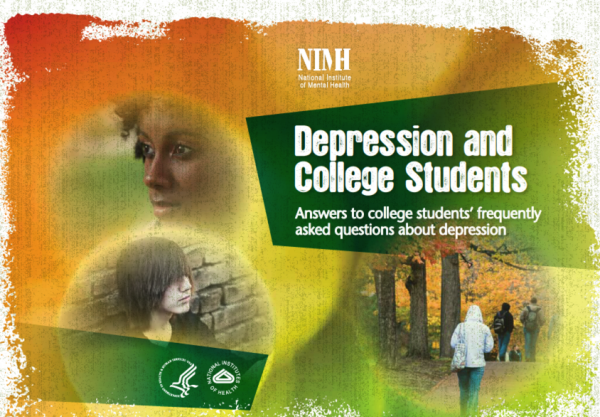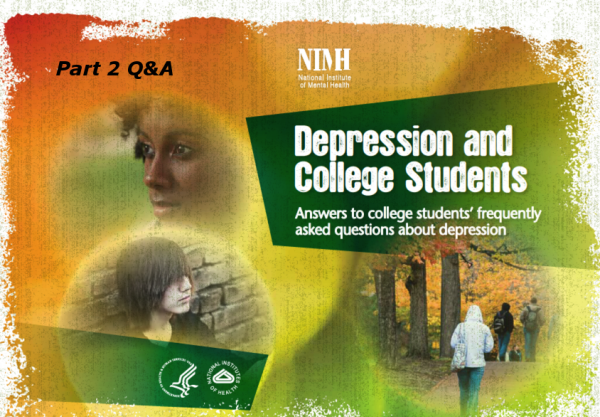Depression and College Students #1 | Q&A for Mental Health Help

Part 1 | Mental Health answers to college students’ frequently asked questions about depression. 
Many people experience the first symptoms of depression during their college years. Unfortunately, many college students who have depression aren’t getting the help they need. They may not know where to go for help, or they may believe that treatment won’t help. Others don’t get help because they think their symptoms are just part of the typical stress of college, or they worry about being judged if they seek mental health care.
In reality, most colleges offer free or low-cost mental health services to students
Depression is a medical illness and treatments can be very effective.
Early diagnosis and treatment of depression can relieve depression symptoms, prevent depression from returning, and help students succeed in college and after graduation.
This blog post addresses common questions about depression and how it can affect students attending college. (Information extrapolated from National Institute of Mental Health).
Q. What is depression?
A. Depression is a common but serious mental illness typically marked by sad or anxious feelings. Most college students occasionally feel sad or anxious, but these emotions usually pass quickly—within a couple of days. Untreated depression lasts for a long time, interferes with day-to-day activities, and is much more than just being “a little down” or “feeling blue.”
How does depression affect college students?
In 2011, the American College Health Association– National College Health Assessment (ACHA–NCHA)—a nationwide survey of college students at 2- and 4-year institutions—found that about 30 percent of college students reported feeling “so depressed that it was difficult to function” at some time in the past year.2
Depression can affect your academic performance in college. Studies suggest that college students who have depression are more likely to smoke.
Research suggests that students with depression do not necessarily drink alcohol more heavily than other college students. But, students with depression, especially women, are more likely to drink to get drunk and experience problems related to alcohol abuse, such as engaging in unsafe sex. Depression and other mental disorders often co-occur with substance abuse, which can complicate treatment.
Depression is also a major risk factor for suicide. Better diagnosis and treatment of depression can help reduce suicide rates among college students. In the fall of 2011 ACHA–NCHA survey, more than 6 percent of college students reported seriously considering suicide, and about 1 percent reported attempting suicide in the previous year. Suicide is the third leading cause of death for teens and young adults ages 15 to 24.9 Students should also be aware that the warning signs can be different in men vs. women.
Q. Are there different types of depression?
A. Yes. The most common depressive disorders are:
Major depressive disorder—also called major depression. The symptoms of major depression are disabling and interfere with everyday activities such as studying, eating, and sleeping. People with this disorder may have only one episode of major depression in their lifetimes. But more often, depression comes back repeatedly.
Dysthymic disorder—also called dysthymia. Dysthymia is mild, chronic depression. The symptoms of dysthymia last for a long time—2 years or more. Dysthymia is less severe than major depression, but it can still interfere with everyday activities. People with dysthymia may also experience one or more episodes of major depression during their lifetimes.
Minor depression—similar to major depression and dysthymia. Symptoms of minor depression are less severe and/or are usually shorter term. Without treatment, however, people with minor depression are at high risk for developing major depressive disorder.
Other types of depression include:
Psychotic depression—severe depression accompanied by some form of psychosis, such as hallucinations and delusions
Seasonal affective disorder—depression that begins during the winter months and lifts during spring and summer.
Bipolar disorder, also called manic-depressive illness, is not as common as major depression or dysthymia but often develops in a person’s late teens or early adult years. At least half of all cases start before age 25. People with bipolar disorder may show symptoms of depression and are more likely to seek help when they are depressed than when experiencing mania or hypomania.
Bipolar disorder requires different treatment than major depression, so a careful and complete medical exam is needed to assure a person receives the right diagnosis. You can find more information in the NIMH booklet, Bipolar Disorder in Adults.
Q. What are the signs and symptoms of depression?
A. The symptoms of depression vary. If you are depressed, you may feel:
- Sad
- Anxious
- Empty
- Hopeless
- Guilty
- Worthless
- Helpless
- Irritable
- Restless.
You may also experience one or more of the following:
- Loss of interest in activities you used to enjoy
- Lack of energy
- Problems concentrating, remembering information, or making decisions
- Problems falling asleep, staying asleep, or sleeping too much
- Loss of appetite or eating too much
- Thoughts of suicide or suicide attempts
- Aches, pains, headaches, cramps, or digestive problems that do not go away.
Depression is not to be taken as a phase, it is serious. Part 2 gets a bit deeper into it, what actions to take for yourself and for someone in need.
if you have any questions and want help, please click on the button above, we are here to help.



